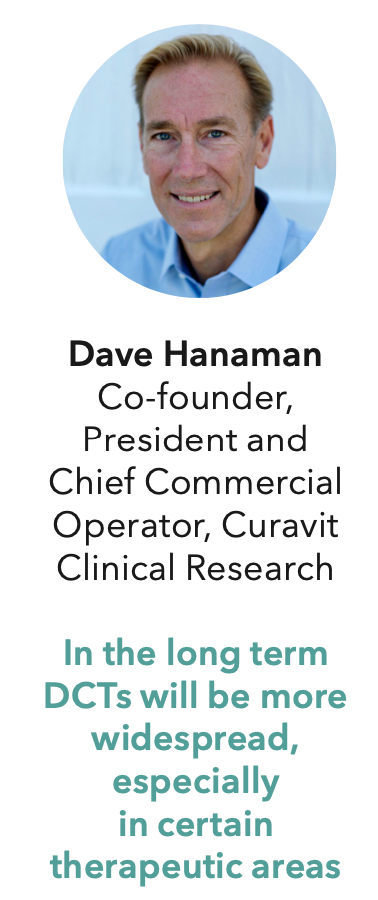Taking DCTs to the Next Level
In this interview, Dave Hanaman, co-founder, president and chief commercial operator at Curavit Clinical Research discusses launching the organization at the start of the pandemic and how it operates with a commitment to designing trials with a fully virtual site.

In line with the industry’s drastic shift to decentralized trials (DCTs) during the pandemic, companies have been quick to adapt. In this interview, Dave Hanaman, co-founder, president and chief commercial operator at Curavit Clinical Research discusses launching the organization at the start of the pandemic and how it operates with a commitment to designing trials with a fully virtual site.
Applied Clinical Trials: What is a VCRO?
Dave Hanaman: Curavit is the first virtual contract resource organization (VCRO), which means that like a traditional CRO, we provide a full suite of services to design and execute clinical trials. The virtual piece is what is new; and it refers to our 100% dedication to DCTs. At Curavit, we design virtual clinical trials from first principles using IoT, wearables, remote data capture and other digital technologies to improve the speed, quality, cost, and accessibility of clinical research. We address each trial uniquely and bring in therapeutic area specialists to help inform the right technologies and approach, and partner with an extensive ecosystem of technology partners as required.
Of course, there are some trials or therapeutic areas that today are much harder to decentralize, but increasingly we are seeing advanced technologies being applied partially, making hybrid trials the most prevalent type for the foreseeable future. In the near term, fully virtual trials may be limited to specific use cases, however, in the long term they will be more widespread, especially in certain therapeutic areas, such as rare disease, mental health, central nervous system, neurodegenerative and others that have supporting technologies and require patient populations that might struggle to physically travel or don’t live near a site.
While there are defining patient population characteristics in many therapeutic areas that can make some studies more likely candidates for all-virtual research, ultimately, the target patient population, treatment, indication, and available technologies will determine whether a trial is fully virtual, hybrid, or a traditional site-based trial.
ACT: Your company was founded right at the beginning of the pandemic. What has that experience been like?
Hanaman: We launched the company in November 2019, right before the pandemic took hold. At that time, the industry was breathlessly predicting that 10% of all trials would be virtual in 10 years. Now the DCT market is exploding with an estimated value of $1.63 billion by 2027, a compounded annual growth rate of 14.8%, according to Precision Reports. No one foresaw the impact of the pandemic and the unprecedented adoption of decentralized trials within months. We found ourselves suddenly accelerating toward our goals with massive tailwinds, but also buffeted by turbulence from the hype. We again learned the lesson that “the first casualty of battle is the plan,” and that you must stay committed to the outcome while adapting to the things you can’t control.
ACT: How does the VCRO differ from DCT providers or platforms?
Hanaman: There are a variety of DCT providers that offer a combination of both services and software in this space. As a VCRO, Curavit is traditional in the sense that we provide services for the entire lifecycle of a clinical trial, but what makes us unique is our primary focus on designing and executing digitally-native DCTs through our proprietary DCT platform. Our platform is the digital manifestation of our IP and processes. From operations, through data collection and insight, to patient experience, our platform is uniquely configured for each study and manages every aspect of a clinical trial. It operationalizes our expertise, is built from industry-leading technology, configured for each trial, deployed to each patient, and available in real time to our sponsors.
ACT: How does the organization maintain relationships in a virtual model?
Hanaman: An unintentional benefit of the pandemic was not only the increased acceptance of telemedicine and decentralized research, but also the comfort level of conducting business remotely. Coincidentally, we started Curavit just months before the pandemic closed down everything, but we had always planned on building a virtual company with hubs in key markets, such as Boston, Philadelphia, San Diego, and Salt Lake City. All the client work we do takes place remotely—in the cloud. We leverage digital technologies to maintain relationships with all our stakeholders, including patient participants involved in the virtual clinical trials that we execute. As the pandemic restrictions permit, we are increasingly meeting customers, employees, and prospects face-to-face at industry conferences, customer sites, and the traditional meetings.
ACT: Does a sponsor use all of your services, or pick what they need?
Hanaman: Sponsors can select the services they need through our DCT platform. This is where they have access to whatever functionality they need for each trial, and can scale up, or down, depending on their needs. Each trial is unique and configured by our clinical operations team on our proprietary platform, validated, HIPAA-compliant, and audit-ready. Trial participants also participate through the platform to upload their data. All stakeholders can access it to track and monitor progress.
For each specific trial, sponsors use different layers of the platform, ranging from patient experience, data capture and analysis, to operational services. For example, we recently designed and delivered a fully virtual COVID-19 therapeutic trial that used several layers of our DCT platform. This trial was configured completely differently than one we are currently executing for diabetes research that leverages different components of the platform.
In short, sponsors choose between a full-service solution for complete DCTs or a digital layer–a subset of our offerings–to solve a very specific challenge in a hybrid clinical trial.

Improving Relationships and Diversifying the Site Selection Process
April 17th 2025In this episode of the Applied Clinical Trials Podcast, Liz Beatty, co-founder and chief strategy officer, Inato, discusses a number of topics around site engagement including community-based sites, the role of technology in improving site/sponsor relationships, how increased operational costs are impacting the industry, and more.